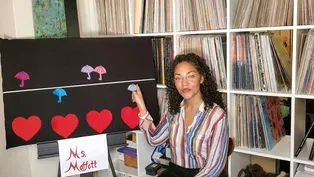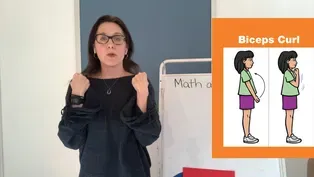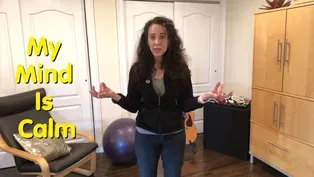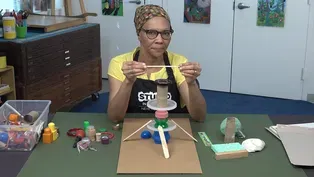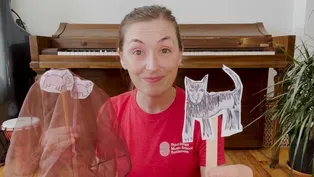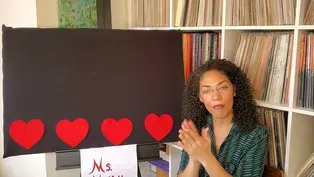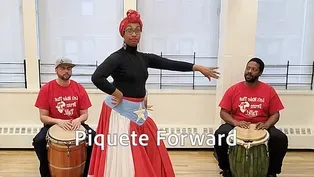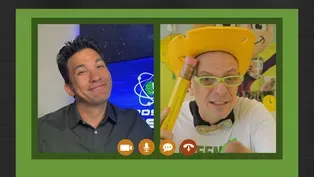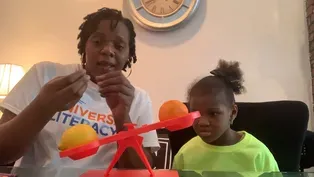
Thin and Thick Both Start with "th"!
2/26/2021 | 55m 45sVideo has Closed Captions
Learn about facades and community service, read HOW MANY STARS IN THE SKY?
Learn about facades and community service, read HOW MANY STARS IN THE SKY? LET’S LEARN helps children ages 3-8 with at-home learning. One-hour programs feature instruction by educators and virtual field trips.
Problems with Closed Captions? Closed Captioning Feedback
Problems with Closed Captions? Closed Captioning Feedback
Let's Learn is a local public television program presented by THIRTEEN PBS

Thin and Thick Both Start with "th"!
2/26/2021 | 55m 45sVideo has Closed Captions
Learn about facades and community service, read HOW MANY STARS IN THE SKY? LET’S LEARN helps children ages 3-8 with at-home learning. One-hour programs feature instruction by educators and virtual field trips.
Problems with Closed Captions? Closed Captioning Feedback
How to Watch Let's Learn
Let's Learn is available to stream on pbs.org and the free PBS App, available on iPhone, Apple TV, Android TV, Android smartphones, Amazon Fire TV, Amazon Fire Tablet, Roku, Samsung Smart TV, and Vizio.
Providing Support for PBS.org
Learn Moreabout PBS online sponsorshipMore from This Collection
Video has Closed Captions
Read SCHOOL BUS and draw one, learn about prefixes and pitch, build sculptures. (57m 48s)
Running and Counting Both End in “ing”!
Video has Closed Captions
Move to improve, find the missing number, learn songs from Ghana, read ABUELITA’S SECRET. (58m 17s)
What Sound Does “aw” Make in Draw?
Video has Closed Captions
Read a story, discover "au" and "aw," learn about density, count, and move with music. (56m 58s)
Can You Find the Short “u” in Subtract?
Video has Closed Captions
Help Super Grover 2.0 solve a prickly problem, read ALL THE WAYS TO BE SMART. (56m 19s)
What Sound Does “gl” Make in Glove?
Video has Closed Captions
Play the glockenspiel, help Super Grover 2.0 make a cart move, read TWO WOOL GLOVES. (58m 9s)
Incredible Starts with Short “i”!
Video has Closed Captions
Solve problems with Super Grover 2.0, catch a rainbow, hear a piano sound like a cuckoo. (56m 9s)
What’s the Sound of “oo” in Book?
Video has Closed Captions
Explore animals’ form and function, sing about the 3 little pigs, read THE LITTLE BOX. (58m 15s)
We’re Reducing, Reusing and Recycling!
Video has Closed Captions
Learn all about rhythm and the number 9, read A BAG IN THE WIND. (56m 17s)
Video has Closed Captions
Learn to dance bomba and grow food in a city, read WOLF CUB’S SONG. (55m 20s)
How Many Syllables are in Invent?
Video has Closed Captions
Invent your own instrument, make 10 to add numbers to 20, read ONE GOLDEN RULE AT SCHOOL. (57m 36s)
Video has Closed Captions
Learn about the science behind mind reading, count shells, read MY BIG FAMILY. (57m 27s)
Which is Heavier: One Apple or Two Apples?
Video has Closed Captions
Defy gravity, learn secret code words for fast and slow in music, read WHOOO KNEW? (58m 5s)
Providing Support for PBS.org
Learn Moreabout PBS online sponsorship[upbeat music] - [Narrator] Ready to learn?
- [Both] Hi!
- [Narrator] It's time to share a story.
- Sh!
- [Narrator] Read and write.
- Let's read it back.
- [Narrator] Discover science, sing.
♪ Somewhere ♪ - [Narrator] Play, and so much more.
- Cupcake!
- Very good.
- [Narrator] Stay tuned for lessons and activities.
- We're gonna start making some words.
Isn't that fun?
- Mm-hmm.
[upbeat music] - [Narrator] Funding for this program was provided by the JPB Foundation.
[upbeat music] - Hi, friends, welcome to story time with me, Miss Darlene.
Have you ever wondered how many stars there are in the sky?
So have I, and so has the main character in today's read-aloud called "How Many Stars in the Sky?"
written by Lenny Hort and paintings by James E. Ransome.
In the story, the main character takes us on a wonderful journey as he tries to count all of the stars in the sky.
Stick around after the read-aloud.
I'll show you how you can paint your very own stars in the sky mural.
So if you're ready, let's have fun reading!
"How many stars in the sky?
Mama was away that night, and I couldn't sleep.
Mama knows all about the sun and stars, but she was away, and I didn't want to wake Daddy.
So I stared out of the window asking myself, 'How many stars in the sky?'
I could count so many just from my room.
I leaned out the window, and I could count even more.
That was just gazing over the backyard.
How many stars in the sky?"
Can you see the stars outside of his bedroom window?
Have you ever looked outside of your bedroom window at nighttime and asked yourself, "How many stars are in the sky?"
Did you ever try to count them?
I wonder if you found a lot of stars or just a little bit of stars.
Let's keep reading to find out if the character was able to find more stars in the story.
"I went outside with a pad and pencil.
I started to count.
I filled up one whole page of the pad, but there were lots of stars hidden behind the trees.
The house blacked out even more.
The street lamp was so bright I couldn't see stars anywhere near it.
How many stars in the sky?"
Hmm, that's a great question.
We know that they are the stars that we can see.
Well, what about the ones that we can't?
Maybe he can move to another location to find even more stars.
Let's keep reading to find out if he does.
"I climbed high up into my tree house.
I started at the Big Dipper and counted in a great circle all around the sky.
I filled up page after page of the pad, but when I got back to the Dipper, it wasn't where I remembered it.
I must've been out so long that the stars had moved.
Old ones had set, and new ones had risen.
How many stars in the sky?"
Hmm, I can see the ones he can see, but what about the ones that set?
That means they lose their glow, and then new stars start to twinkle, hmm.
I climbed down from the tree house, and there was Daddy.
'I couldn't sleep,' I said.
'I can't sleep either,' he said.
'Your mama won't be back till tomorrow.'
I told him, 'I wanted to count all the stars in the sky.'
'If your mama was here,' Daddy said, 'I bet she'd know.
Maybe you and I can find someplace where it'll be easier to count them.'"
Let's stop and think for a moment.
What do you think would be an easier place to find and count stars?
Well, we know that houses can block them out.
Trees can block them out, and bright city lights can block them out as well.
So where do you think they should go?
That's right, somewhere where it might be a little bit darker.
Let's see where they end up.
"My dog hopped in the truck with us, and we drove into town.
The streets were quiet, but lots of streetlights were burning.
We could see the bright city skyline in the distance."
Even though we could see a couple of stars, the sky still looks pretty bright, and it looks bright because of all the lights and all the city buildings and the streetlamps and the cars and the department store window lights.
It can make it really hard to see the natural starlight.
"Daddy and I counted 25 or 26 stars.
He said he thought one of them was the planet Jupiter.
'This isn't a good place to see stars,' I said.
'It's not a bad place to count them, though,' he said, 'but it's still too hard.
Let's go where it would be really easy.'
We drove into the city.
The big clock by the tunnel said 2:45, but neither one of us felt like sleeping."
Do you see any stars in the sky in this picture?
Why do you think we can't see any stars?
That's right, so many city lights.
There are searchlights on top of tall buildings and towers.
I see streetlights and traffic lights.
What other kind of lights do you see?
That's right, all of these types of city lights make it hard for us to see the natural stars in the sky.
"We parked by Mama's office.
There was a department store with brightly lit displays in every window.
There were streetlamps on every corner.
There were dazzling neon signs.
Headlights flashed from a steady stream of cars.
Powerful searchlights beamed from the roofs of the skyscrapers."
Well, still no sky lights.
"And I couldn't see any stars at all.
'I count exactly one,' said Daddy.
'No, wait, it's an airplane.'
'Maybe the stars just don't wanna be counted,' I said.
We drove back through the tunnel.
I was tired, and I thought we were going home, but instead, Daddy drove us deep into the country."
What do you think they'll find when they go deeper into the country?
Do you think there are as many buildings or streetlights?
Let's keep reading to find out.
"There weren't any cars.
There weren't any streetlights.
There weren't any houses.
Even the moon had set, and I knew we could never count all the stars."
Wow, look how many stars in the sky now!
I even noticed that the sky is even a darker blue, and the darker the sky, the brighter the stars!
"No matter where I looked, new ones appeared every time I blinked my eyes.
Daddy pointed up above and showed me the Milky Way.
The stars were so thick, I couldn't tell 'em one from another!"
We've got many stars to count now.
It must be beautiful!
"We were much too tired to drive anymore, so we slept underneath the stars that night.
It was daylight when we woke.
'Daddy,' I said, 'all those stars are always out there even when we can't see them, right?'
'Of course they are,' he said.
'Can we try to count them again sometime?'
I asked.
'Any night you feel like it,' he said.
'You and me and Mama can all go out together.'
I could hardly wait to see Mama and tell her all about it.
In a little while, we'd all be back home.
But now, I was glad just to be standing there with Daddy basking in the warmth of the one star we could see."
Hmm, I wonder what star you can see in the daylight?
"And that was the sun!"
Did you know that the sun is a star?
Well, it is.
I really hope that you enjoyed the story.
Stay tuned, and I'll show you how you can make your very own stars in the night sky painting at home.
For today's activity, we are going to be painting our very own stars in the sky mural.
I noticed in this story, there were beautiful paintings of the night sky.
I noticed lots of dark blues on the top of the page and bright white dots that represent the stars in the sky.
So to make our very own star-in-the-sky painting, we're going to need some thick white paper or card stock, just any paper that will not allow water to soak through to the other side.
You're going to need a paintbrush, a white crayon, a cup of clean water to clean and wet your brush, and some watercolors.
Before we start painting, I wanna tell you a little bit about crayons.
Did you know that there are oils in crayons?
Well, what do you think happens when you mix oil and water?
That's right.
The oil repels the water.
So we are actually gonna draw our stars first, and then we're going to paint on top of our stars, but something really cool is going to happen.
Because we know that oil repels water, when we use the watercolors to paint over our stars, it won't cover them!
Let's see what I'm talking about.
First, cover your page with as many white stars as you like.
Don't worry if you can't draw a perfect star.
Remember, in the story, the painter used white dots to represent bright stars in the sky.
So you can use dots, or you can make small letter Xs to represent stars, or if you can draw a star, go right ahead, let's get to it.
I'm gonna cover my page with white stars, and right now, they're going to seem invisible, but you'll see later what happens when I add my watercolors.
Now, here comes the magic.
First, wet your brush in your cup of clean water.
Then, as you start to paint across the paper, you'll start to see all of the stars that you drew, look!
Because the watercolors are repelled by the oil in the crayon, the paint will not cover the stars that I already made.
So I'm gonna cover my entire picture.
Keep wetting your brush as much as you need to to get as much blue color on your paintbrush to make the night-blue sky.
And there you have it, your very own stars in this night sky mural.
Wow, friends, I had so much fun painting with you all today.
And my mural is all dry, and I can still see all of the beautiful white stars that I added with my white crayon.
How many stars did you add to your mural?
Remember, the next time it's dark out, look outside your window, just like the character in the story and try to see how many stars you can find in the night sky.
And as always, keep reading!
- Hi, movers and shakers, this is Violet, and today we have some special guests.
My cousins Liam and Aidan are gonna help us sing a song called "Rattlin' Bog."
They're gonna sing the call, and I'm gonna sing the response.
That means they're gonna say something, and I'm gonna repeat after them.
Can you help us sing this song together?
Great, all right!
♪ O-ro the rattlin' bog ♪ ♪ Way down in the valley-o ♪ ♪ O-ro the rattlin' bog ♪ ♪ Way down in the valley-o ♪ ♪ And in that bog ♪ ♪ And in that bog ♪ ♪ There was a tree ♪ ♪ There was a tree ♪ ♪ A rare tree ♪ ♪ A rare tree ♪ ♪ A rattlin' tree ♪ ♪ A rattlin' tree ♪ ♪ And the tree in the bog ♪ ♪ And the bog down in the valley-o ♪ ♪ O-ro the rattlin' bog ♪ ♪ Way down in the valley-o ♪ ♪ O-ro the rattlin' bog ♪ ♪ Way down in the valley-o ♪ ♪ And on that tree ♪ ♪ And on the tree ♪ ♪ There was a branch ♪ ♪ There was a branch ♪ ♪ A rare branch ♪ ♪ A rare branch ♪ ♪ A rattlin' branch ♪ ♪ A rattlin' branch ♪ ♪ And the branch on the tree ♪ ♪ And the tree in the bog ♪ ♪ And the bog down in the valley-o ♪ ♪ O-ro the rattlin' bog ♪ ♪ Way down in the valley-o ♪ ♪ O-ro the rattlin' bog ♪ ♪ Way down in the valley-o ♪ That was so much fun!
Thanks, Liam and Aidan.
Thanks, everyone!
[upbeat music] - Hi there, I'm Erica, and I'm so glad you're here.
Today, we're going to be having some fun with words.
We're going to be learning some new sound spellings.
We'll learn about two digraphs, W-H and T-H. We'll also learn about two trigraphs, T-H-R and T-C-H. We're going to read, spell, and sort words with those digraphs and trigraphs.
Since we're going to be spelling in a few minutes, would you please go get something to write with and something to write on?
I have a dry-erase marker and a whiteboard, but you can use anything you have, a crayon, a pencil, a pen, or the back of an envelope if you have to write on, a piece of paper, a notebook, or if you have a whiteboard like me.
I'll give you a few seconds to go grab that, and then we'll get started.
[lively music] Whoa, you are so fast!
Okay, great.
So we're going to start with our digraphs, and just to remind you, a digraph is when you have two letters that are joined together.
They stand for a new sound.
Let's take a look at our first one.
W-H, as in the word whistle.
Say that word again, whistle.
Yeah, W-H represents or stands for that wh sound at the beginning.
It's also the same sound in the word when.
W-H appears at the beginning of words.
Our next digraph is T-H, as in the word thermometer.
Say that word again, thermometer.
Yeah, your tongue is by your teeth there, thermometer.
It's also the first sound in the word thin.
T-H can appear at the beginning or at the end of the words, but here's the thing with T-H.
It can also have a slightly louder sound, as in the word this.
The way you know the difference is if you place your hand on your throat and you say it again, this, and you can stretch out that beginning sound, this.
Do you feel that vibration?
Yeah, that's that slightly louder sound.
Now try it with the word thin, thin.
Did you feel that vibration?
Hmm, not so much.
That's how you know the difference.
T-H is also going to help us with our trigraph, T-H-R, as in the word three.
And we have one more trigraph to go, T-C-H. And you might be wondering, why is it with C-H and a picture of a cheetah?
Well, it's because T-C-H represents that same sound of C-H, ch, like in the word cheetah.
T-C-H appears at the end of words, like in the word catch.
Now, one thing that can help you today is I placed when, wh, W-H, at the beginning to help remind you that W-H appears at the beginning of words, and I've placed T-C-H at the end to help remind you that T-C-H appears at the end of words.
That was a lot.
I think I'm going to need to catch my breath.
[exhales loudly] Did you catch yours?
Okay, let's move on and read some words.
So I'm going to run the pointer underneath all the letters here, and we're going to say the sounds those letters stand for or represent.
Then we'll blend it with the next sound, and then we'll say the last sound, and then blend all of it together to read the word.
Watch what I do with the first one so you get to know what I mean.
We have T-H here, as in thermometer, th.
Now, we have the vowel I here after these consonants, so it's gonna make a short sound.
It's gonna represent the ih sound, thi.
And then C-K represents ck, and we'll the put all of that together, thick, thick.
Thick is the opposite of thin.
My sticky note is thin, but my board is thick.
Great, join me for this next one.
We have W-H, as in whistle.
Here's that short I again, whi.
Blend that, whi, and then ch.
Now, put it all together, which, which.
Now, it doesn't mean that lady with a silly hat that rides a broom.
Which means what one are you talking about?
So if I say, "Which vegetable would you like, carrots or broccoli?"
I want you to say what one do you want, which of the two vegetables do you want.
That's that which.
Do you think you can do this one on your own?
I think you can, so I'll point, and then I'll run it along to help you blend, and I'll say it at the end so you can check in with me.
Okay?
Let's try it.
Here's a hint!
Same vowel I.
Okay, blend.
And there are two Ls, but it'll just make one l. Okay, can you put it all together?
Blend it a little faster.
Did you say thrill?
Yeah, great job!
Try this last one on your own.
Our trigraph is at the end.
Remember, it's like ch.
Blend the first two sounds.
Say the last sound.
Blend it all together, faster.
Shout it out!
Yes, hitch, great job!
Okay, so let's move on to spelling some words.
So this is where you're going to need your writing utensil.
I have my marker here.
I'm going to say a word, and we're gonna stretch it out and write the letters that represent those sounds, okay?
Our first word is them, them.
Hmm, them, I feel something here at the beginning, that vibration.
Yeah, it's that T-H, theh, eh, eh, I know, E stands for that eh sound, them.
What's that last sound?
Mm.
Yeah, them, did you write it like this?
Great, okay, here's our next word.
When, wh, wh, at the beginning.
Here's a hint!
Yes, I see you wrote W-H, wheh, eh, eh, nn.
Nice!
Okay, here's our next one, patch, patch.
See if you can do that one on your own, patch.
Can you stretch it out?
Patch.
Yes, oh, so exciting!
Shout out the letters!
Yes, P-A-T-C-H!
It was at the end!
Patch is, means if something is torn, you might cover it up or fix it, you patch it up.
We usually do that maybe with fabric.
If you have a torn shirt or a pair of pants and you fix it up, you patch it up.
Here's our last word, throb.
Stretch it out, throb, throb.
Oh my goodness, yes!
Okay, shout out your letters!
That's our trigraph at the beginning.
Let me fix my R there.
Throb, yes, have you ever run really, really, really fast and then you feel like your legs are a little painful, and they're beating?
We can say that your legs are throbbing.
That's a different way to say it.
Okay, we're onto our last part.
We're going to sort words.
So I've written four words here, that, whip, three, and catch, and I've underlined our digraphs and trigraphs.
I'm going to hold up a different word, and we're going to be looking and listening for those digraphs and trigraphs.
If it's the same one as the one at the top of the column, we'll place that word in that column.
Watch what I mean.
Here's my first one, with, with.
Hmm, I feel my tongue by my teeth, with.
Yes, like that.
Remember I said, T-H can come at the beginning or at the end of words.
Let's try with this next one.
Which, yep, you read this word before, which.
You were so quick!
Which, which column does it belong underneath?
Yes, with whip.
It has that wh at the beginning.
Here's our third one, hatch, hatch.
Yes, I hear you all shouting catch!
That's our trigraph, T-C-H. Thrill.
Thrill, yes, we read this one before, too.
It's our other trigraph, T-H-R at the beginning of the word, like in three.
Thrill means that's something's really exciting.
Thrush, thrush.
Yes, T-H-R again!
You guys are so good at this.
Whiff, whiff.
Yes, at the beginning like which and whip.
Whiff means if you get a smell of something.
So if you get a whiff of freshly baked cookies or flowers, something that smells nice, and sometimes something that doesn't smell so nice, but whiff means a smell.
Then.
Yes, like that and with.
Here's a bonus point!
Is it the softer sound or the louder sound?
Remember what to do.
Yes, I see you placing your hand by your throat.
Say the word, then, stretch it out, then, th, then, do you feel the vibration?
Yes, great!
Okay, here's our last one.
Watch, watch.
Yes!
You all did a fabulous, amazing, great, great, great, great work.
There's so many words I can't even think of any!
Oh, it was so great, and I'm so excited that you were here today.
We learned about digraphs W-H and T-H and our trigraphs T-H-R and T-C-H. That was a lotta work you did today, and I'm so, so proud of you.
And I can't wait to see what you do next time, so please come back and watch what we do next!
Thanks, bye.
[upbeat music] [calm music] - My name is Doris.
My husband, David, and I, we have two children, Dalia and Daniel.
- One.
- [laughs] Go for it.
Our hope for our children is that they are happy, confident, and caring so that they can thrive in school and in life.
- Ah!
- Got you!
- When I became a mother, it was very important for my children to be able to name and express their feelings so that they can better deal with their emotions.
Remember these?
When my children were very young, we started using picture books as tools to identify emotions within characters.
Sometimes I'll ask them questions to help them begin to identify their feelings for themselves.
I see a sad face, is that right?
- Mm-hmm.
- [Doris] If they can connect to their own feelings, then they can connect to others' feelings.
- I only had a little- - [Doris] We make time daily to ask questions and practice listening.
- How was your day, Daddy?
- Oh, my day was amazing, Daniel.
- [Doris] And I think it just really shows them how to be a good friend and the importance of thinking of others.
- Congratulations, Dalia.
- [Doris] Tapping into feelings has helped my children with confidence and self-awareness.
At school, they know how to manage feelings as they come up so that they can focus on learning.
- All right, so have a good day in school, okay?
[calm music] [upbeat music] - Hi, it's me, Andrew, and I am back with another activity from the built environment in your community.
Today, we're going to learn about a very important word of something in the built environment.
The word is facade.
Let's spell that word.
F-A-C-A-D-E, facade.
Does the word facade sound like any other word that you know?
Does it remind you of another word?
Facade, this word sounds a lot like the word face, and that is exactly what a facade is.
The facade is a building's face.
So the facade is the outside or front part of a building.
Think about a person that you know, a person in your family or a friend.
What does that person's face look like?
Does their face look different from your face?
When you compare your face with another person's face, you will notice that some things are the same, but you'll also notice things that are different.
Maybe this other person has eyes or a nose or a mouth or ears that are a different size or a different shape than yours.
You can see what I mean by looking at these two faces here.
Do you see any differences between these two faces?
Look at the shape and the color of the different features on the faces.
What's different from one face to the other one?
Examples of things that are different in these two faces would be the shape of the eyes, the color of the hair, the size of the mouth, and the shape of the nose and the ears and the color as well.
Every person has a face, but not every person's face is the same, and it's like that with facades on buildings as well.
Every building has a facade, but facades can look very different from each other.
Let's look at an example.
Let's look at two different buildings and compare their facades.
Here are two pictures of building facades.
What do you see that is the same about these two facades?
What do they have in common?
What do you notice about them that is different?
One thing that these facades have in common is that they both have windows and a front door.
But there are a lot of things that are different, such as the shape and size of the building, the materials that the buildings are made out of, or maybe other details that you noticed.
Facades can look different for a lot of different reasons.
They might look different because of the materials that are used to make the building or how old the building is, where the building was made and when, and there's also special features that some facades can have on the outside to decorate them.
We're going to learn about some of those features now.
The facade of a building is made up of many different shapes.
Do you see shapes that you recognize in this facade?
I see some triangles.
How many sides does a triangle have?
That's a shape with three sides.
So we see some triangles with three sides.
Do we see some squares or rectangles?
How many sides does a square or a rectangle have?
Those are shapes that have four sides.
We see some of those as well.
Especially the windows and doors are rectangles.
Are there any other shapes that you see?
What material do you think this facade is made out of?
This is an example of a building that is mostly made out of wood, which comes from trees.
Building facades can be made of many different materials, and that's why they can look so different from each other.
Let's look at another example of a very different building.
What material do you think this building is made out of?
Here's an example of a building that's made out of a shiny material that you can see your reflection in on the outside.
What material would that be?
Glass, so this building has metal probably inside it, but on the outside, there's glass.
Stone could be another material that you would often see in building facades.
Many facades have special features to decorate the outside of them.
We're going to learn about four different features of facades.
Here is the first feature.
Do you see the part at the top of the building that is highlighted?
This is called the pediment.
The pediment forms a certain shape at the top of the building.
What shape is that?
It's got three sides, so this is a triangle.
So it's a triangular shape at the top of a building.
Here's another feature that some facades will have.
This one is called a cornice.
What part of the building do you see this shape?
It's all the way up at the top of the building.
The cornice is kind of like a crown on someone's head.
It sits at the very top of the building.
What shape would you say that this cornice is?
Well, it's a little bit like a rectangle.
It has four sides, so this is a rectangle that sits on top of the building.
Openings in the facade, like doors and windows, will have a straight line going across them, kind of like a rectangle.
This is another part of the facade called the lintel.
So here is the lintel.
And let's look at one more example.
Look closely at the part of the facade that is highlighted on this picture.
You will see some small shapes on the outside of the building.
What shapes are these?
They look like little squares with four sides.
This is a special feature of the facade called the dentils.
Does the word dentil remind you of another word?
What about the word dentist?
What does a dentist do?
A dentist is the doctor who takes care of your teeth, and dentils on a facade of a building are called that because they look like little teeth on the outside of the building.
So these are the building's dentils.
Now, we're going to play a guessing game.
I'm going to read the definitions of those four different features that facades have on the outside, and see if you can remember what the name of the feature I'm talking about is, see if you can guess which one I'm talking about.
Listen to each clue and see if you can remember the name of the part of the facade that I'm talking about.
The four different names of those four parts of the facade are also written on the screen.
Okay, here is the first clue.
This is a part of the facade that is like a crown on top of a person's head.
It's a rectangle that sits at the very top of the building.
What part of the facade am I talking about?
Did you say cornice?
If you did, you are correct.
I'm talking about the cornice of the facade.
Okay, here's the next clue.
This is a rectangle that goes across the top of an opening in the facade, like a window or a door.
What's the name for the part of the facade at the top of a window?
If you said lintel, you are correct.
This is the lintel of the facade.
For the next clue, this is a part of the facade that looks like little teeth, looks like little teeth in a row on the outside of the building.
If you said dentil, you are correct.
The little teeth are called dentils.
And let's do one more clue.
This is a part of the facade that can be at the very top of a building, just like a cornice, but this is shaped like a triangle.
What's the name for the triangle shape at the top of the facade?
If you said pediment, you are correct.
So the last one was the pediment of the facade.
Today we learned about the facade, which is the face or the outside front part of a building.
When you look at the facades of buildings in your community, can you see any of the features that we talked about?
Like, do you see dentils or the lintel of a window or a door, or do you see a cornice or a pediment anywhere?
Look around at the buildings in your community and their facades and see if you can find these features.
You may not be able to see all of the features, or you might not even find any of them, depending on what the buildings in your community look like, 'cause just like buildings and their facades can be very different, not every community is going to look the same.
Join us next time for another activity about the built environment in your community, bye!
[upbeat music] [calm music] - [Doris] My name is Doris.
[interpreter speaking Spanish] - One.
- [laughs] Go for it.
[interpreter speaking Spanish] - Ah!
- Got you!
[interpreter speaking Spanish] - Remember these?
[interpreter speaking Spanish] I see a sad face, is that right?
- Mm-hmm.
[interpreter speaking Spanish] - How was your day, Daddy?
- Oh, my day was amazing, Daniel.
[interpreter speaking Spanish] - Congratulations, Dalia.
[interpreter speaking Spanish] - All right, so have a good day in school, okay?
[upbeat music] - Oh, hi there, friends!
Well, I was just checking my mail, and I got really excited because I got a letter from Miss Sabrina!
So excited that I wanted to tell you all about it right away, because I figured you might wanna read it with me.
"Dear, Miss Heather and friends," that's you!
"How are you doing?
We've been cleaning out all of our closets, and let me tell you, the boys really have grown a lot.
So many of their clothes just do not fit them anymore.
So we are making plans to figure out which clothes we're going to donate to one of our local organizations."
Oh, that's a really great idea.
"Well, tell all of our friends how much I miss them.
See you soon, Miss Heather.
Love, your friend, Miss Sabrina."
Oh, Miss Sabrina, we miss you, too.
You know, going through your clothes and donating 'em is such a great way to help people out in our community.
You know what?
Today, friends, that is exactly what we're going to be talking about.
Today we're gonna be learning about ways that citizens just like you and me can serve our community.
When people serve their community, we call it community service.
Wait, you know, friends, I remember Miss Sabrina talking to us about the word service and what it means.
Huh, do you remember what the word service means?
Oh, wait, I think I remember.
Huh, you know, let's just hear it one more time from Miss Sabrina.
What does the word service mean?
- A service is when you do something that helps someone or make sure that people have what they need.
For an example, in a town or a city, we have services which include delivering mail, collecting trash, and serving food.
- Oh, thank you, Miss Sabrina, for reminding us about the definition of the word service.
So community service is when we help out and serve people in our community, people like you and me who volunteer and donate our time.
You see, some people have jobs that provide the community with a service, but even if you don't have a job that serves the community, all of us can do work and volunteer our time to help make a community a better place to work, live, or play.
There are lots of different ways that we can help the community a better place.
One of the first steps to helping out our community is to figure out and make a list of some of the things people in our community need.
Friends, can you think of some things that people may need in our community?
- And our community, we need to make sure people are safe from the coronavirus.
- We have to help our environment by reducing waste, recycling, not littering, and reusing items if we can.
- Hi, everyone, in our community, we have to help people that are older and cannot leave their houses.
- You can help by helping them with their food deliveries and other household goods.
- People in the community need food to eat.
- Our community needs to help people with jackets, shoes, and clothes.
- You know, lots of people in New York City do community service in lots of different ways.
Recently, we went to visit the Brooklyn Rescue Mission Bed-Stuy Farm in Brooklyn, where they help bring food to people in their community.
When we were there, we met with the cofounders, Reverend Robert Jackson and Reverend DeVanie Jackson, who have been running a food pantry and a community farm for 18 years.
We got a chance to meet them and some of the people who help them, both at the food pantry and the farm.
Let's go meet them together now.
- Hell, everyone, today we are at Brooklyn Rescue Mission Bed-Stuy Farm, and today, we are going to learn more about community service.
- My name is Nicky Carter.
The first time I could remember volunteering was in kindergarten when my teacher, Mrs. Carter, same last name, and then she wanted me to pass out like the pamphlets and like homework papers to my classmates.
I started volunteering because I like to help people.
I was like kinda low on food, so I came here, and that's when I met Mr. Jackson and Mrs. Jackson, and ever since then, and Mrs. Lowe, and ever since then, I've been working here.
- Today, let me introduce you to Reverend Robert Jackson and Reverend DeVanie Jackson who're going to show us all about the Bed-Stuy Farm.
- The Brooklyn Rescue Mission was formed as an organization in 2000, but Brooklyn Rescue Mission Bed-Stuy Farm has been in operation since 2004.
And we've been in operation growing the food for folks who are in need of healthy, good food in communities who are fighting food insufficiency and hunger.
So we've been growing food for our food pantry for the last 15, going on 16 years.
I think community service is important because it teaches people leadership.
It teaches people decision-making and how to solve problems.
It also allows them to be concerned about others but also grown solutions to problems that exist.
The volunteers at the Bed-Stuy Farm water.
They help plant seeds and plants.
They help take care of the chickens, and they help take care of the worms in the worm bins.
And they're able to actually see food grow and then harvest it.
- Places like the Bed-Stuy Farm help people learn about compassion, working together, help bridge cultural differences.
People get to know one another for who they are.
I think it breaks down stereotypes and barriers, and ultimately everybody's human beings.
Anything we could do together as a group for the greater good is going to help people.
Really, service came out of the desire to see equality and justice and spread the wealth and the love.
And I think that people in need and there's extra resources somewhere else, you just need a bridge to help.
It's just not about giving food.
It's about sharing information and sharing knowledge, sharing the physical work, and helping people to better their place in life and true overall quality of life for all of us as humans on this planet.
- [Olivia] Thank you so much for showing us around your farm today.
- Thank you so much, Mr. and Mrs. Reverend Jackson, for showing us around the food pantry and the farm.
You see, there are lots of things that people need, and sometimes we're not able to get them.
You see, friends, people in communities need certain goods like food or clothing, shoes, and sometimes people just need to have contact with other people, and we may have a hard time getting them.
So community service is a way that we can all help each other out.
So what are some of the other ways that we can help serve our community?
- In our community, people bring food for others.
- There are places in the community where people make food for people to bring home and eat.
- Our community has a community garden.
People volunteer to help plant flowers, water, and weed plants.
Community gardens are places for people to go to.
They can grow food or just enjoy the garden.
- Food pantries give out food to people who can't afford the groceries they need.
- Right now, it is hard for lots of people to buy clothes they need.
Kids like us grow a lot!
- One way to serve your community is to go through all the clothes that you have and take them to a local shelter.
- Donating to a local shelter is a great way to serve your community.
You can donate clothes, shoes, toys, or sheets.
These are important things that people need.
- Well, thank you, friends, so much for sharing all of the different ways that we can do community service.
Listening to you has made me think how easy it is to help out even when we're home.
Okay, so Olivia, these don't fit you anymore, right?
- Yeah, these don't fit me.
- Okay, so we'll donate those.
- Yeah.
- Oh, hi there, friends.
You know, just like Miss Sabrina, we've decided to go through some of our old clothes and shoes and see what we could donate.
Well, thank you so much, friends, for joining us today and learning about all of the different ways that you can help out in your community.
Citizens just like you and me, there's always things that we can do to help serve people in our community.
So now it's time for us to say- - [Both] See ya later!
- And it's time for you to find some ways to help people in your community.
- Until next time, thank you for joining us for today's social studies lessons.
[bright music] - [Narrator] Funding for this program was provided by the JPB Foundation.
[bright music continues] [wondrous music]
Let's Learn is a local public television program presented by THIRTEEN PBS
